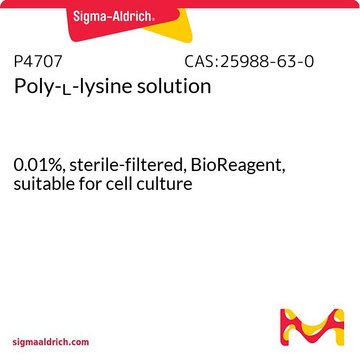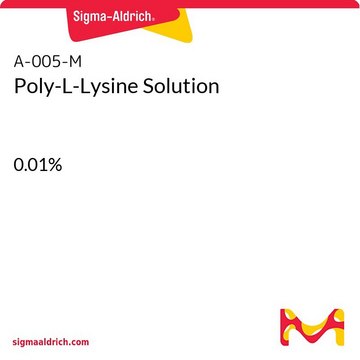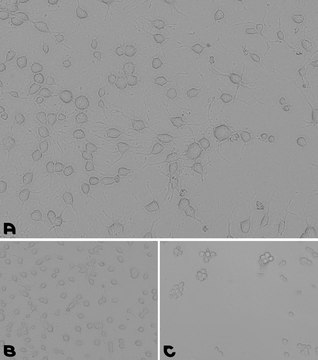推荐产品
产品名称
聚-D-赖氨酸溶液,1.0 mg/mL, The Poly-D-Lysine solution promotes the adhesion of tissues/sections to the culture vessel.
质量水平
表单
liquid
制造商/商品名称
Specialty Media
技术
cell culture | mammalian: suitable
输入
sample type neural stem cell(s)
sample type epithelial cells
sample type: human embryonic stem cell(s)
sample type hematopoietic stem cell(s)
sample type mesenchymal stem cell(s)
sample type pancreatic stem cell(s)
sample type induced pluripotent stem cell(s)
相关类别
一般描述
多聚-D-赖氨酸(PDL)是α-聚赖氨酸的一种手性形式,是通过合成产生的阳离子多肽。它是一种非特异性的细胞粘附分子(CAM)。PDL广泛用作体外和离体实验中的涂层材料。
应用
多聚-D-赖氨酸已用于:
- 涂覆培养皿,为神经细胞的生长和附着提供合适的表面。
- 准备盖玻片表面,以促进非粘附细胞的附着。
生化/生理作用
多聚-D-赖氨酸(PDL)是阳离子,有助于组织/细胞上阴离子位点的交互效应,从而促进与生长表面的有效附着。带正电的PDL与带负电的细胞膜相互作用,并促进神经突的生长。共价结合的PDL层促进神经细胞的长期培养。
特点和优势
- 多聚-D-赖氨酸(PDL)溶液在磷酸盐缓冲盐水(PBS)、水或0.1M硼酸盐缓冲液中稀释。
- 通常,50μg/mL至100μg/mL的工作稀释度足够。
- 它的表面覆盖率为3-10μg/cm2。
- PDL可在-20 ˚C下储存长达18个月。
- 在4˚C下储存时,培养板可以涂覆3小时过夜,最多可保存3天。
- 涂有PDL的培养板可以立即使用,或在PBS中储存最多5天。
外形
液体。20ml溶于无菌水中。
制备说明
包被水平会因不同种属和类型的细胞而异。通常,表面积为3-10μg/cm2的最终涂层浓度通常将为大多数电池类型提供足够的涂层。 板的表面积:(Pi)(半径平方)以cm22为单位 具体而言,以50μg/mL至100μg/mL的工作稀释度通常就足够了。 用PBS、水或0.1 M硼酸盐缓冲液{通过在400 ml水中加入1.24 g硼酸和1.9 g四硼酸钠制备,pH 8.5}稀释聚-D-赖氨酸至最终工作浓度。 将平板或烧瓶包被3小时至过夜,如果在4℃下储存,则最多可包被3天。最好的效果通常是过夜涂层。 移除聚-D-赖氨酸溶液,用无菌PBS或水1-2X冲洗。请勿刮擦包被板或烧瓶的底部。 立即使用平板或与PBS一起储存长达5天。 聚D-赖氨酸包被方法会因实验室而略有不同,请将该方法用作一般指南。
储存及稳定性
在-20℃下可储存18个月。
储存分类代码
12 - Non Combustible Liquids
WGK
nwg
闪点(°F)
Not applicable
闪点(°C)
Not applicable
LGALS3 (galectin 3) mediates an unconventional secretion of SNCA/?-synuclein in response to lysosomal membrane damage by the autophagic-lysosomal pathway in human midbrain dopamine neurons
Burbidge K, et al.
Autophagy, 18(5), 1020-1048 (2022)
Detection of G-Quadruplex DNA Structures in Macrophages
Kastl M, et al.
Methods in Molecular Biology, 2713, 453-462 (2024)
Characterization of Seeding Conditions for Studies on Differentiation Patterns of Subventricular Zone Derived Neurospheres
Sanchez-Mendoza EH, et al.
Frontiers in Cellular Neuroscience (2016)
Evaluation and Optimization of Poly-d-Lysine as a Non-Natural Cationic Polypeptide for Gene Transfer in Neuroblastoma Cells
Sanchez-Martos M, et al.
Nanomaterials (Basel, Switzerland), 11(7), 1756-1756 (2021)
Enhancement of neuronal cell adhesion by covalent binding of poly-D-lysine
Hee Kim Y, et al.
Journal of Neuroscience Methods, 202(1), 38-44 (2011)
我们的科学家团队拥有各种研究领域经验,包括生命科学、材料科学、化学合成、色谱、分析及许多其他领域.
联系技术服务部门





